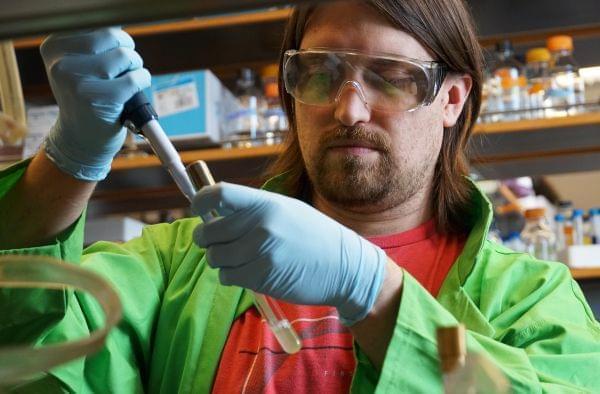Germ-Killing Chemical Shields Bacteria From Antibiotics

Washington University postdoctoral researcher Corey Westfall is part of a team investigating how the chemical triclosan interferes with antibiotic treatment. Shahla Farzan/St. Louis Public Radio
A common chemical used to kill bacteria is making them more capable of surviving antibiotics.
According to new research from Washington University, triclosan has a protective effect on strains of E. coli and methicillin-resistant Staphylococcus aureus, or MRSA.
The chemical — which is added to hundreds of consumer products — also interferes with the antibiotic treatment of urinary-tract infections in mice.
The U.S. Food and Drug Administration banned triclosan and 18 other antibacterial chemicals from consumer soaps in 2016, on the grounds that they are “not generally recognized as safe and effective.”
Triclosan is still added to a wide range of products as an antibacterial ingredient, including toys, yoga mats and kitchenware.
Triclosan is often used at very high concentrations, said Petra Levin, a professor of biology at Washington University and co-author of the study.
“The problem with that is triclosan doesn’t degrade very easily,” Levin said.
In the United States, an estimated 100 metric tons of triclosan are deposited in the environment through wastewater treatment alone.
It’s not just an issue of environmental contamination, said Levin. About 75 percent of people nationwide have detectable levels of triclosan in their urine, according to previous research.
Triclosan makes bacteria harder to kill
In one of the first studies of its kind, Levin and her colleagues have shown triclosan is having unintended effects on the bacteria it’s supposed to kill.
In a lab experiment, both E. coli and MRSA bacteria were more tolerant of antibiotics when treated with triclosan.

The strain of E. coli used in the study. The cell wall is shown in red and the DNA is shown in blue.
E. coli treated with triclosan were more than 10,000 times more likely to survive certain antibiotics. The study found the chemical also increased the proportion of “persister cells” — bacteria that are extremely tolerant of antibiotic treatment.
Typically, about one in a million bacteria survive antibiotics. But when treated with triclosan, that number jumped to one in 10.
It took much longer for triclosan-treated bacteria to die, said Corey Westfall, a postdoctoral researcher at Wash U and study co-author.
“For at least one of the antibiotics, 10 percent of the triclosan-treated cells were still alive after 20 hours,” Westfall said, “which is quite shocking, because normally by that point, they should all be dead.”
The chemical also made it much more difficult to treat mouse urinary-tract infections with antibiotics.
The team is investigating how exactly triclosan interferes with antibiotic treatment, but Levin said the results serve as a warning about the ubiquity of germ-killing chemicals on the market.
“When we use antimicrobials in consumer products, we don't think about the consequences it might have in this big-picture way,” she said. “They're getting into our water and our soil, and we don't know what they do.”
Follow Shahla on Twitter: @shahlafarzan
Links
- Preparing For Cold Weather; Juvenile Life Sentences; Mosque Bombing Pleas; Antibiotic Overuse
- Congressman Says Bill Would Encourage Drug Companies To Develop New Antibiotics
- Report: Federal Rules Haven’t Curbed Antibiotic Use In Pork
- Concern Grows Over Antibiotic Resistance
- Researchers Engineer Bacteria To Create A Million New Chemicals For Drug Discovery
